#1916 fashion design
Explore tagged Tumblr posts
Photo

1916 Jean Philippe Worth, fashion design, fashion sketch, satin evening dress by House of Worth.
#1916#fashion design#jean philippe worth#fashion sketch#evening dress#house of worth#satin evening dress#1916 fashion design#1910s fashion#10s fashion#la belle epoque#art nouveau#art nouveau fashion
142 notes
·
View notes
Text
In the video, Revri and Rexstrew spotlight Episode 7, “The Case of the Very Long Stairway.” But there’s history leading up to that moment throughout Season 1. Specifically in Episode 6, “The Case of the Creeping Forest,” when Edwin changes his outfit for the first time — ghosts don’t really take the time to switch up their wardrobes in Dead Boy Detectives. He’s wearing a cozy green sweater and tells Charles that he has feelings for men. Charles puts both his hands on Edwin’s shoulders, facing him, as a sign of his unconditional love and support for Edwin’s sexuality. “For me, I always knew that Charles was the only one that can get through to Edwin through touch,” says Revri. “Edwin wouldn’t want anyone else to really touch him.” It’s an important moment for their friendship, signifying that Edwin is starting to open up about his feelings and his attire reflects this. “To change Edwin is a big deal because Edwin doesn’t like change,” costume designer Kelli Dunsmore tells Tudum. “He had no collar. He had no bow tie.” Up until Episode 6, Edwin is always buttoned-up and closed off, protected in his tailor-made suit. “Hiding everything,” says Dunsmore. It was Rexstrew’s pitch to have Edwin wear something different for that episode. “I just thought it could be an interesting way to get Charles’ attention,” says Rexstrew. “It’s like this really innocent and desperate little attempt.” In the scene, Revri chose to add in a line acknowledging the fashion statement. “It felt right for Charles to notice that Edwin dressed up nice,” he says.
But in Episode 7, Edwin specifically confesses his feelings for Charles, after his best mate descends to the depths of hell to save him. When the boys hug at the end of Episode 5, “The Case of the Two Dead Dragons,” the meaning of Charles’ touch changes for Edwin. “He starts to crave it,” says Rexstrew. “It’s been unlocked by the Cat King (Lukas Gage), and then Monty (Joshua Colley) is more of a teenage crush kind of connection. But it’s all leading up to this.” While Charles can’t fully reciprocate Edwin’s feelings now, he completely embraces and accepts him. He’s Edwin’s first true love, and he doesn’t push it away. “You kind of leave it open,” says Rexstrew. “Definitely,” adds Revri. Together, they rehearsed over and over again in Rexstrew’s room before filming. They spoke a lot about levels, as Charles is physically higher up on the stairs and Edwin is below, which adds to the vulnerable nature of the scene. “We really wanted to make sure that it was perfect, right?” remembers Revri. When filming came around, Revri was blown away by Rexstrew’s ability to bring out so much emotion after seemingly holding back in rehearsals. “Well, it was hard. It’s very difficult being in love with you. What can I say?” jokes Rexstrew. The scene also comes after Edwin finds his old bully Simon (Gabriel Drake), who was responsible for Edwin being sent to hell back in 1916. But he learns that Simon was also a closeted boy who was scared of his feelings. “Edwin realizes in that moment, ‘You can’t live your life with regret,’ ” says Rexstrew. “ ‘You can’t live your life not saying what you feel.’ ” Both actors hope that fans find comfort in Edwin and Charles’ relationship as chosen family. “Even if you’re born into a scenario where those around you don’t accept you for who you are, there are people out there for you,” says Rexstrew. Stream Dead Boy Detectives now, only on Netflix.
Everybody say "Thank you, George & Jayden"
[Colors and bolds mine]
#i owe these actors my life at this point tbh#the queer rep is!!!!!!!!!!!!!!!!!!!!#dbda#dead boy detectives#dead boy detective agency#dead boy detectives netflix#text post#article#interview#link#tudum#jayden revri#george rexstrew#i'm dying dude this interview#queer cinema#queer history#gay#bisexual#lgbtqia#happy pride 🌈#pride month#stream dead boy detectives#renew dead boy detectives#payneland#charles rowland#edwin payne#dbda cast#fave#save#reference
370 notes
·
View notes
Text








From The Russian Army 1914-18
Early War Uniforms (1914-1915)
At the outbreak of the war, Russian Imperial Army uniforms were traditional and formal, inspired by 19th-century European military fashion. Key features included:
Infantry: Soldiers wore the gymnastiorka, a pullover-style tunic with a standing collar, often in olive green or khaki to blend with rural landscapes. Rank was indicated by colored collar tabs and shoulder boards.
Headgear: Soldiers wore the M1910 peaked cap, which had a leather visor and badge. Officers and guards regiments wore the iconic shapka, a tall fur hat, especially in colder climates.
Footwear: Soldiers wore sapogi (knee-high leather boots), which were sturdy but hard to maintain on the battlefield.
Cavalry and Specialized Units: The cavalry wore the traditional long blue or dark green overcoat with distinct colored cuffs and collar insignia. Cossack and other specialized units had specific, unique uniforms, often featuring traditional garments like the cherkesska (a type of coat) and decorative braid.
Mid-War Changes (1915-1916)
As the war progressed, Russia’s economy and industry struggled to keep up with demand, leading to simplifications in uniforms:
Tunic: The gymnastiorka became simpler, often without the colored collar tabs or decorative elements. Khaki shades became standard as brighter colors were deemed impractical.
Greatcoat: The heavy wool shinel (overcoat) remained a staple, especially during harsh winters, but there was a shortage of quality fabric, and lower-quality cloth began to appear.
Headgear: Caps were simplified, with many soldiers receiving the budenovka (a soft, pointed wool cap) by 1917. This cap became especially popular in winter regions but had limited protection.
Late-War Uniforms (1917-1918)
The Russian military was increasingly influenced by revolutionary sentiments, and practical, minimal designs became the norm:
Tunic and Coats: Uniforms were pared down further, with basic olive-drab tunics and greatcoats. Rank insignia were minimal and often overlooked as soldiers became more focused on function than formality.
Insignia: Some units began to remove the imperial insignia altogether due to the influence of the Bolsheviks. Instead, red armbands or patches occasionally appeared.
Boots: Soldiers frequently substituted traditional boots with puttees (long cloth wraps) due to the shortage of leather, a trend seen across European forces during this period
#military art#history#cavalry#soldier#military#historical fashion#the great war#world war 1#russian history#russian empire#tsar Nicholas ii#imperial Russian history
101 notes
·
View notes
Text

April, 1916 Fashion pages from "Harper's Bazar" magazine. Designs by Lucien and Hats from Gage. Click to enlarge!
209 notes
·
View notes
Text

Palasaki week day 2: dead girl detectives
Crawls out of hole in the ground hi hello here I am fashionably late as always (don’t procrastinate challenge: impossible) honestly I was so lucky that I didn’t have school today, or yesterday, or I straight up wouldn’t have been able to make it, I’m pretty sure. Also this gave me hand cramps, learn from my mistakes and don’t draw on your phone, I won’t stop ofc, but you know do as I say not as I do or whatever.
Anyway I’m rambling i’ll just go over the designs and then we’ll move on to story
Niko: my only real ideas for Niko, was that bunny ear bow, cause those are cute as fuck. So I ended up researching Japanese 80s fashion, it wasn’t very helpful but I did end up seeing that off the shoulder cardigan, and was like yes, that is perfect. And of course, the mushrooms are a reference to her ep 3 outfit.
Crystal: again my designs aren’t very complicated. I found a shirt-skirt combo that I thought was perfect for Crystal, but then I was like what if pants? So I wrestled with that for a little while, but decided to go with pants, because first of all it’s practical, second, I don’t think Crystal would give a shit about dress etiquette.
Story (don’t judge to hard, it’s the middle of the night, and I wrote this in like 10 minutes): our story begins back in 1916, where Crystal makes a deal with a demon for her soul thinking he loves her, she gets possessed and dies in the process getting stuck in hell for the next 73 years. When she gets out she meets Niko, who’s currently dying from the sprites effects, so Crystal end up keeping her company in her final moments.
They start up an agency in New York (or Washington dc idk) solving cases with Crystal’s powers and Niko’s compassion (and excellent reading comprehension skills ofc)
Now in present day, they’re solving a case about some dangerous books being in the the wrong hands, which leads them directly to a boarding school, where one nerdy occult obsessed exchange student is about to be sacrificed (aka Edwin) he obviously wants to go back to England after this whole horrible experience, and they end up following him, after Crystal gets a vision about a little girl (Emma in this au) being in danger, back in the UK.
They solve the whole Emma business, and help her back home (Mrs. Knights home for wayward children) where they meet Charles, who’s taking refuge there to escape his dad (and since Edwin has the magical amnesia now he ends up moving in too)
And that’s all I got lol
#palasaki week#palasaki week 2024#palasaki#dead boy detectives#crystal palace#crystal palace surname von hoverkraft#niko sasaki#save dead boy detectives#revive dead boy detectives#renew dead boy detectives#our ghosts matter#Emi’s scribbles#dbda fanart
133 notes
·
View notes
Text

1916 Fashion plate (Confection Einhorn Luzern) by workshop of Max Dalang, Zürich
(Museum of Design Zurich)
61 notes
·
View notes
Text
WW I Part II
Women's fashion has less ornament and detail. Pockets were stictched on the exterior of women's skirts and jackets instead of hidden in seams. Jackets were worn longer over the hips and looser fitting with belts wrapped around the waist. Women's waists were no longer emphasized as they had been with corsetted dress. Women's skirts were shorter and showed their shoes.

Suits by Chanel in silk and wool jersey.
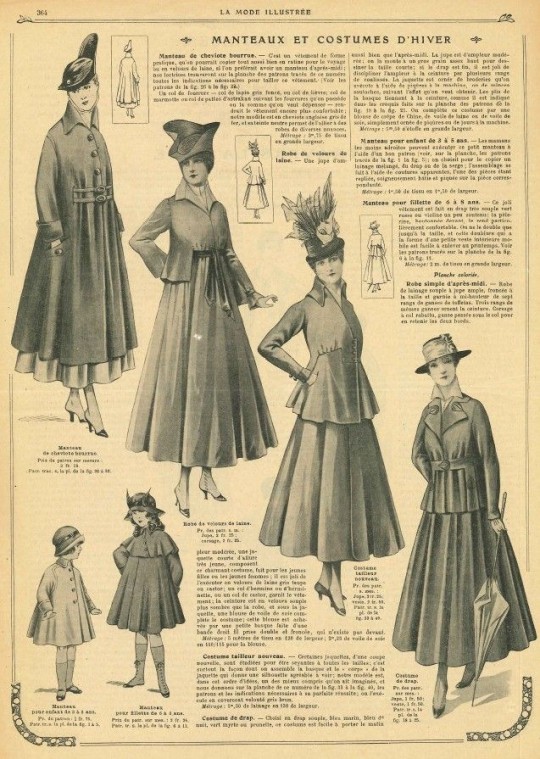
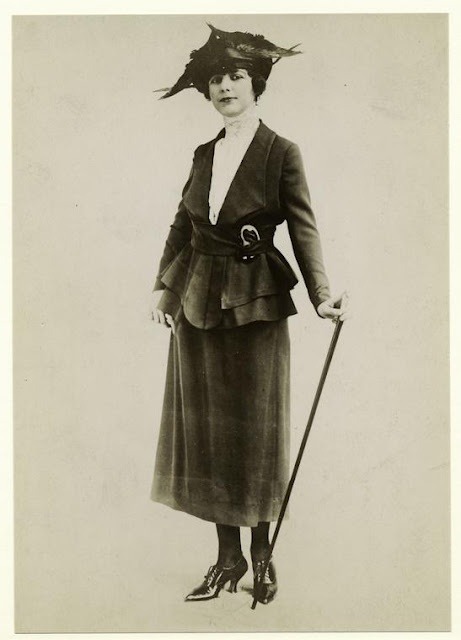
La Mode Illustrée, October 8, 1916 | Woman's suit • 1918
Though we don't think of haute couture and war as having anything in common, in France the manufacturing and export of fashionable clothing for women helped to keep the economy going during World War I.

Fashion Plate for the French magazine Les Elegances Parisienne • 1916

While Coco Chanel got her start during the great war, it was Paul Poiret who was the star of the era's high fashion. Referred to as the King of Fashion in America in the 1910s, Poiret is most famous for his designs influenced by Orientalism, Neoclassicism, and Surrealism; the kimono, the Turkish trouser, the slit skirt, and the famous lampshade dress. Mostly, he is remembered for his stance on women’s fashon and the simplification of the female silhouette. He dismissed the petticoat and the corset, as the trends shifted away from tailoring toward draping. He disliked the word fashion, opting instead to design women’s clothing solely as an expression of individuality. “Women are wrong for following one style,” he said.

Paul Poiret's "lampshade" fashions
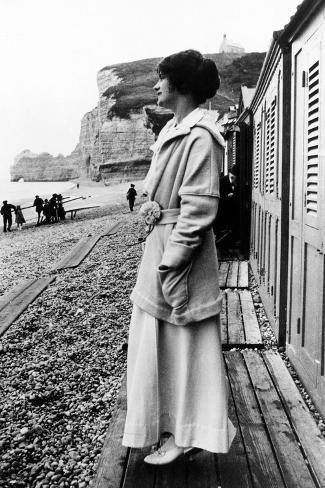

Chanel photos. The one on the right was taken in front of her first boutique in 1914.
#fashion history#women's fashion history#ww 1 fashion#chanel#paul poiret#the resplendent outfit fashion/art blog#vintage fashion photos#the lampshade dress#1910s fashion catalog#1910s fashion plates
46 notes
·
View notes
Text



BLACK HISTORY IN FASHION DAY 2 - Ann Lowe
'Considered one of America’s most significant designers, Ann Lowe was born in Clayton, Alabama, around 1898 and reared in Montgomery. In 1916, a chance encounter in a department store with influential Tampa socialite Josephine Edwards Lee changed Lowe’s life. Mrs. Lee observed that Lowe’s outfit was fashionable and exceptionally well-made. Lowe informed her that she made the ensemble, which prompted Lee to invite Lowe to Florida (as a live-in dressmaker) to make the bridal gowns and trousseau for her twin daughters. After discussing the offer with her husband, who wanted her to remain a housewife, Lowe accepted the offer and moved with her son to the Lee family estate at Lake Thonotosassa in Tampa. She later described the opportunity as “. . . a chance to make all the lovely gowns I’d always dreamed of.” In Tampa, she developed a list of loyal clients and supporters. In 1928, Lowe closed the Annie Cone boutique and permanently moved to New York, where she continued to design for elite women and their families. Over the course of her life, she operated several shops in New York, including Ann Lowe Inc. at 667 Madison Ave. during the late 1940s and early 1950s; Ann Lowe Gowns at 973 Lexington Ave. in 1955; A.F. Chantilly Inc. at 558 Madison Ave. in 1965; and Ann Lowe Originals in Manhattan on Madison Avenue in 1968 until she retired in 1972. The Madison Avenue locations solidified Lowe as the first African American to have a shop on the famed fashion retail strip, and it attested to her significance as an American couturier of note. The 1950s marked a significant turning point in Lowe’s life and career. She opened Ann Lowe Inc. with business partner Grace Stelhi, wife of the owner of Stelhi Silks. Located at 667 Madison Ave., Lowe was the first African American to own a couture salon on this fashionable street. By the end of 1953, the partnership had dissolved, and Lowe’s son joined her as bookkeeper and supply manager. Her financial affairs improved, as she was less a businesswoman and more a couture artist. Lowe’s fairytale-like gowns appeared in Vogue and Vanity Fair magazines. Her creations were respected by renowned designers such as Christian Dior and Edith Head, and she earned key commissions and obtained greater geographical exposure from high-end luxury department stores such as Montaldo’s, Neiman Marcus, and I. Magnin. Lowe’s most historically significant commission was the bridal gown and bridal party dresses for the 1953 wedding of Jacqueline Bouvier and then-Sen. John F. Kennedy, who would become president of the United States in 1961. About 10 days before the wedding, a ruptured pipe in Lowe’s building destroyed the wedding gown and 10 of the 15 bridesmaid’s dresses. Lowe and her team of seamstresses recreated the dresses, but ultimately, she sustained a $2,200 loss in income. She never reported the loss to the Kennedy family. Lowe was chosen by the bride’s mother, Janet Auchincloss, with whom she had a long-standing relationship. When Janet Auchincloss married Hugh Auchincloss in 1942, Lowe created her wedding gown. She also designed the debut gown of Nina Auchincloss, Jacqueline’s stepsister, which appeared in Vogue in 1955. Lowe worked for the Auchincloss family until 1957. '
SOURCE
17 notes
·
View notes
Text
Today's The Blue Castle research is Valancy's green crepe dress. So first, here are a collection of descriptions of the dress:
She got a pretty green crêpe dress with a girdle of crimson beads...
She felt so miserably undressed in its low neck and short sleeves. And that low, crimson girdle around the hips seemed positively indecent.
Above it her eyes had looked like odd brown jewels and the girdle had given her flat figure an entirely different appearance.
It was nonsense to feel so—so—naked—just because her neck and arms were bare.
There's been a lot of talk about how the timeline of this book is a little all over the place. I found a collection of fashion sketches from 1912-1950 from the Brooklyn Museum that gives a wide range of fashion from the time. Here are some drawings that I think with some adjustments could match Valancy's dress, or at least parts of it. I will say I'm not a seamstress so I'm not sure if these would work with crepe fabric.
First up: 1914 dress goes to show that a lower waist still did occur in the 1910s, even if it was more rare than the empire/natural waist. Imagine it in green with the sash around the hips being replaced with the "girdle of crimson beads"

Here's an evening dress from 1915 that can also with some adjustments could fit the description. The tie at the waist here could very much match the "beads" as it looks more narrow. The skirt is likely more full and embellished, but I do like the top as Valancy notes that her "neck" is showing but nothing more than that.
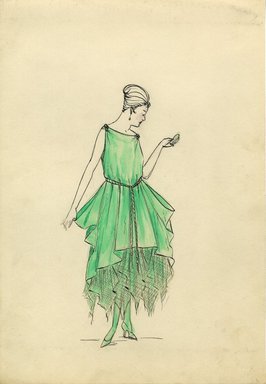
An afternoon dress from 1916 that will require a bit of imagination with colors as this is all black.
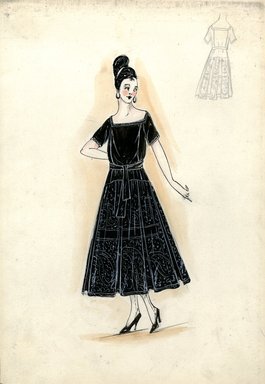
1918 day dress that might be my favorite. The colors would have to be switched, but overall this has the right shape to it to me. Plus there's a hat that works with the hat Valancy has!

1920 day dress. I like that this one is a bit more simple, which makes it feel a bit more likely an ordinary person could have a dress like this, again with a change of colors.
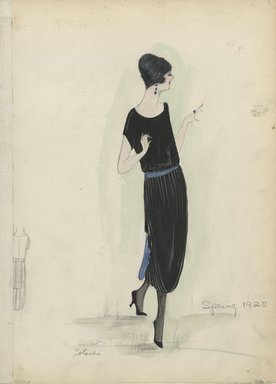
1920 evening dress. This one is fun because it's green just like Valancy's crepe dress. I think the only note is that the girdle would be red and not quite as voluminous at the side. This is another one of my favorites, maybe because the model is giving Valancy vibes.
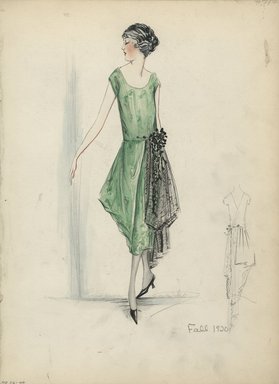
1921 day dress. This is a bit more of a toned down version of the previous one, again with some imagination about the sash being red and beaded.

1921 day dress. I think with just some shorter sleeves, this one works well with the description given. I know she doesn't have flowers as her belt, but also I wouldn't be mad if this was the design for a movie.

63 notes
·
View notes
Text
George W. Maher, architect - part 2
My previous post focused on Maher-designed houses on Hutchinson St., now a Chicago historic district. For this post, I spent part of a day photographing some of Maher's other residential work in Chicago.
Stevenson-Colvin House
Address: 5940 N. Sheridan Rd.
Year Built: 1909
Architect: George W. Maher

The Stevenson-Colvin House
The Harry M. Stevenson house at 4950 N. Sheridan Road dates to 1909 and is a rare survivor of the large homes that lined the street in the first decades of the 20th century. The house, referred to today as the Colvin house for its second owner, features a distinctive Maher dormer, second floor windows recessed behind columns, and a motif of tulips and triangles. It has been restored in recent years and now functions as an events venue.
Classic Chicago Magazine
I took the following photos of the Colvin House during a past Open House Chicago weekend, sponsored by the Chicago Architecture Center:







Unfortunately, the interior has been remodeled, removing virtually all of Maher's original design. The chandelier, however, and the stair rail, are original. The house is now an events venue.

Residence of Edwin M. Colvin, Esq., Chicago. The Architectural Record, 1916 Feb., v. 39, p. 175. ill, plans.
J.H. Hoekscher House
4506 N. Sheridan Rd., 1902


4506 N. Sheridan shortly after completion in 1902 (Inland Architect)
Interior photos available here
King / Nash House, 1901-1902
3234 W Washington Blvd., Chicago

This house is an amalgamation of the Sullivanesque, Colonial Revival, and Prairie styles. It was originally commissioned by wealthy businessman Patrick J. King, but its most well-known occupant was the influential Irish-Catholic politician Patrick A. Nash, who lived here from 1925 to 1943, when Washington Boulevard was one of the city's most-fashionable addresses.
Chicago Landmarks
Davey Pate / Charles Comiskey House, 1901
5131 S. Michigan Ave., Chicago


Maher designed this house for Chicago lumberman Davey Pate. The house was later owned by Charles Comiskey, long-time owner of the Chicago White Sox baseball team.
Magerstadt House, 1906-1908
4930 South Greenwood Avenue, Chicago



Completed the same year that Maher was devising a master plan for the Northwestern University campus, the Magerstadt House sits sideways on its deep, narrow lot, with the front door facing what is now the driveway. Visible from the street is a rectangular side porch whose pillars sport carved poppies.
Chicago Magazine


Elevation and plans above and photos below, HABS survey documents
This house is probably one of the finest works of George W. Maher, a contemporary of Frank Lloyd Wright, and one of the Prairie School. It shows a relationship to Wright's work of the time in its cubist massing, ribbons of windows, simple, low-pitched roof, and deep, unbroken eaves. The influence of Art Nouveau is also evident, as is seen in the extensive use of the poppy motif in the ornament and interior finish.
Library of Congress






This photo and other interior views on Redfin
Link: Magerstadt House HABS Report
5 notes
·
View notes
Text
For Almost A Century, The Kuertz Family Guarded Hazelwood’s Natural Beauty
On the north side of Montgomery, a couple of nature preserves perpetuate the memory of Hazelwood, a once wild corner of Hamilton County. The Harris M. Benedict Nature Preserve is owned by the University of Cincinnati and the adjacent Johnson Preserve was donated to the City of Montgomery.
One hundred years ago, Hazelwood was rural enough to need its own deputy game warden. That role was filled by a truly eccentric gentleman named Louis Kuertz. Warden Kuertz knew the land around Hazelwood intimately and he knew many of the woodland creatures individually.
Rube, a crow, would alight on his hand or shoulder upon being called. When Kuertz hollered across the lake on his property, a turtle named Monte would rise from the lacustrine depths and waddle up to his feet. Kuertz was instrumental in having quail designated as a songbird – and therefore exempt from hunting – in Ohio.
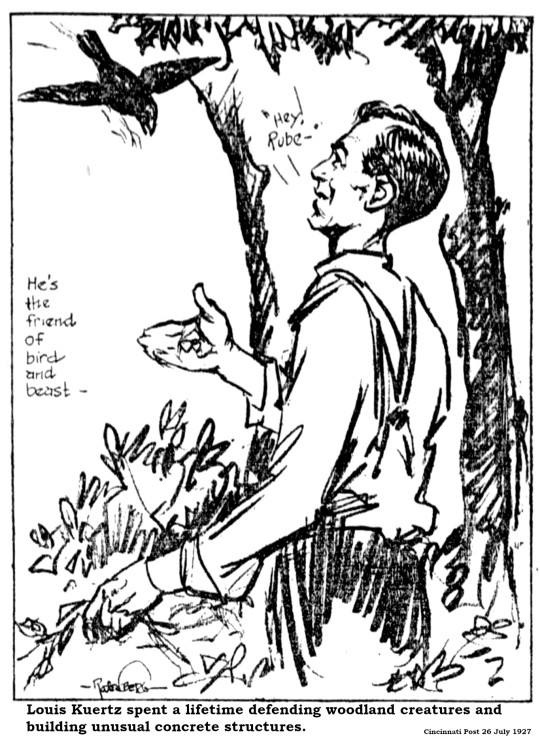
Kuertz worked variously as a truck farmer, a cabinetmaker and as game warden, and passed along his devotion for the natural world to his wife, Anna Belle, and especially his daughter, Gertrude. When Gertrude was just 12 years old, she inspired newspaper coverage because she would trek into the autumn woods to help her father locate poachers. The Cincinnati Post [4 November 1914] noted that Gertrude knew how to identify snipe, plover and quail and was proficient with a gun and fishing rod.
“Gertrude also studies butterflies and flowers and prefers books on botanical and avicular subjects to fairy tales. In winter she goes about in the woods scattering food for wild creatures that otherwise might starve.”
Gertrude’s affection for animals extended as well to domesticated varieties. In 1916, the Post ran a series of articles, allegedly composed by a turkey named Trixey as that chubby bird awaited the arrival of Thanksgiving. With all the build-up, the Post’s readers would have expected a traditional and savory end to the gag. Instead, on Thanksgiving Day, the Post located Trixey “in full bloom of life, smiling pleasantly” at the Kuertz farm. Gertrude was there to explain:
“’We do not slaughter our pets,’ said Miss Kuertz proudly.”
The article went on to list other animals who would not provide sustenance to the Kuertz family, including a red-haired pig named Ruddy, Nana the pony, Bossie the cow and Nanny, a goat of unusual variety donated to the Kuertzes by the Cincinnati Zoo.
“Ganders and geese, ducks and drakes, pigeons and chickens and pheasants and quail – all immune from the swish of the butcher’s knife.”
Gertrude also had a pet hawk. Her interests extended to the vegetable kingdom as well. When the Association for Preservation of Wild Flowers launched a campaign in 1921, Gertrude served as poster girl, holding a sign encouraging flower lovers to leave enough blooms to reseed for the next year.
There came a time when Frank Mills Jr. came courting and the Kuertz family naturally wanted to be sure he was as committed to environmental matters as their daughter. Mills derived from a well-known Cincinnati family. His father, Frank Senior, was the longtime director of the Cincinnati Athletic Club. A nude photograph of the elder Mills hung for many years at the club as an example of perfect manly physique. Apparently the Kuertzes approved, for a wedding date was set.
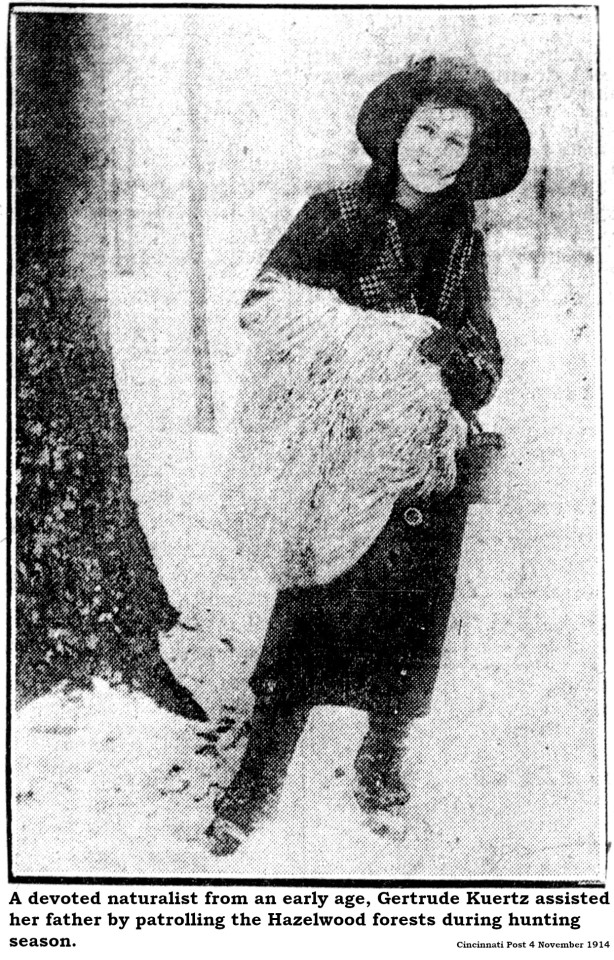
These days, it is considered conventional, if not downright old-fashioned, to be married in a church. A century ago, church marriages were the gold standard. Pretty much the only alternative to a religious venue was the local magistrate’s office. No one got married outside. Unless you were Gertrude Kuertz.
When Gertrude and Frank Mills said their vows on 3 October 1925, it rather caused a stir in Cincinnati social circles because the ceremony took place under the trees at the Kuertz family farm out in Hazelwood. The Cincinnati Post [8 October 1925] devoted several columns to the event:
“In what church was she to be married? She knew no place more sacred than the woods in which she had seen Creation march among her trees and touch them with life and where she witnessed since her childhood the gentleness of the divine love, even to the least of creatures. The woods were to be her church.”
As irregular as it might have seemed at the time, Gertrude’s outdoor wedding was officiated by the very proper Dr. Edward P. Whallon, described as “a minister of the Old School” in an official history of the Presbyterian Church.
The wedding culminated in a good-sized banquet, also served under the boughs of the great trees, illuminated by several bonfires. After the wedding, Gertrude’s appearances in the newspapers were largely confined to the gardening columns. She and Frank, a chemist by trade, excelled at growing almost anything except corn. Frank told the Post [7 July 1965]:
“There are too many varmints around. First the chipmunks dig up the seeds, then the rabbits eat the tender shoots and if there’s any left, the woodchucks strip the ears.”
And, of course, Gertrude would be opposed to shooting any of the brigands.
Gertrude and Frank lived most of their married life in a house personally constructed by her father on the family farm, next door to the house she grew up in. They raised a son and a daughter there.
Louis Kuertz had his own idiosyncratic architectural style that involved knocking together a rough iron framework and covering it with layers of stone and concrete. Kuertz built several such structures, including a bell tower for the local school, in the Hazelwood area. The house Kuertz built for his daughter was known to the nearby community as the Gingerbread House. It looked very much like the houses pictured in fairy tale books and had unique touches including dozens of nooks and crannies and a fireplace sculpted to look like a tree. All the doorknobs turned backwards and all the light switches were installed upside-down. Louis Kuertz died in 1933 and his ashes were placed under a memorial stone on the family estate.
Over the years, bits of the Kuertz farm were sold off. The Gingerbread House survived on a remnant acre until 1992, when it was sold to a developer by Gertrude’s daughter and was promptly demolished.
7 notes
·
View notes
Text


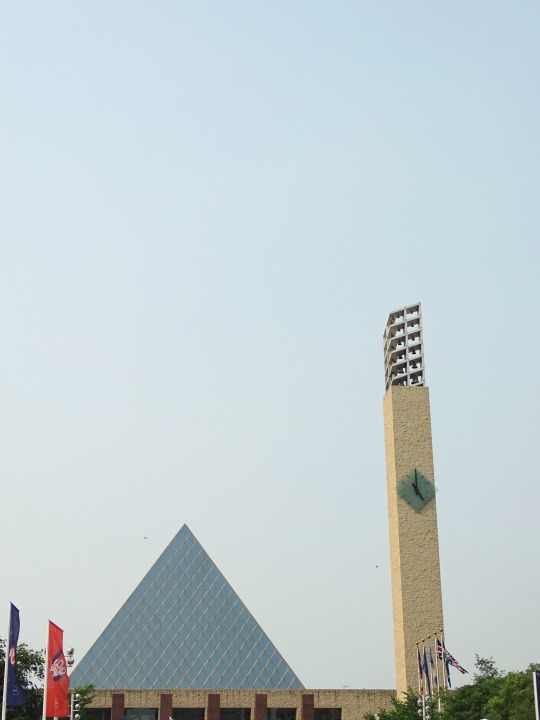



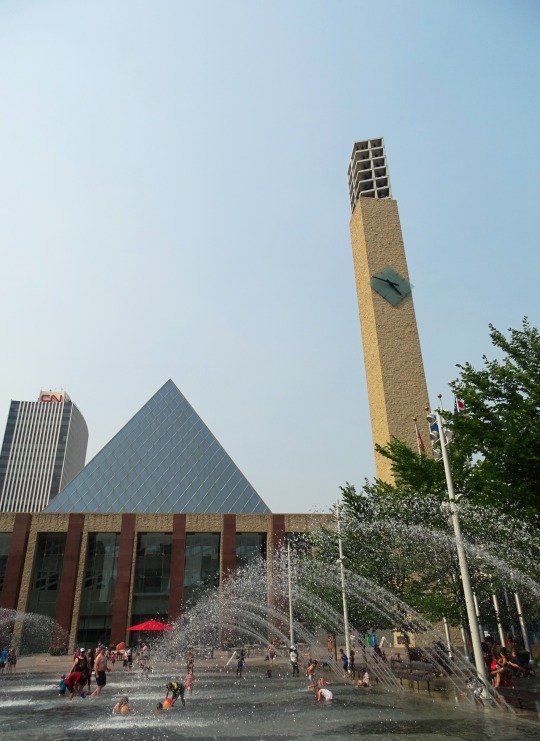

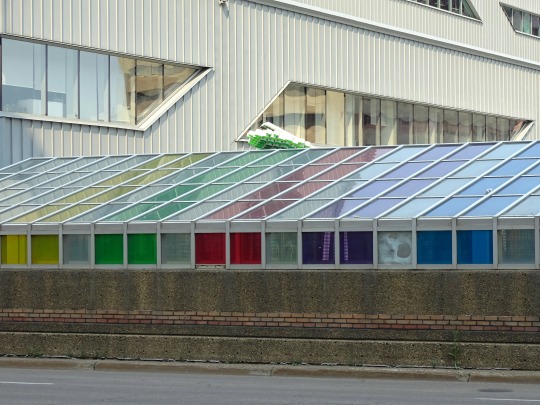

Churchill Square, Edmonton (No. 2)
Churchill Square (officially "Sir Winston Churchill Square") is the main downtown square in Edmonton, Alberta, which plays host to a large number of festivals and events including: the Edmonton International Street Performers Festival, Edmonton Fashion Week, The Works Art & Design Festival, Taste of Edmonton, Cariwest, and Edmonton Pride.
It is bordered on the north by 102A Avenue, on the west by 100 Street, on the south by Harbin Road (102 Avenue) and on the east by Rue Hull (99) Street. In 2009, 102A Avenue was closed to vehicle traffic permanently, providing easier pedestrian access to City Hall.
Surrounding the square are several cultural and governmental buildings, including Edmonton City Hall to the north, the Law Courts and the Art Gallery of Alberta to the north-east, Chancery Hall and the Francis Winspear Centre for Music to the east, the Citadel Theatre to the south-east, the Stanley A. Milner Library (the main branch of Edmonton Public Library) to the south and Edmonton City Centre mall to the west.
The centrepiece of the square builds a life-size bronze statue of Churchill, unveiled by Lady Soames on May 24, 1989. It is a copy of a statue made by Oscar Nemon.
Historically, Edmonton's main square was Market Square, located just to the south of Churchill Square, on the site of the present Milner Library. The City Market was housed in Market Square from its beginning in 1900, originally with the market happening outdoors. Successive plans were considered to develop the square into a civic centre, beginning in 1912. A building was built far away on 107 Avenue for the market to be moved indoors in November 1914, but was never used for this purpose and was boycotted by vendors and customers. The market returned to its original location and the city agreed to help construct a shelter. Beginning in 1915 the market was moved indoors, and by 1920 only overflow stalls were outside. From 1916, when the shelter was built, to 1965, when it moved off the site, the market flourished as the hub of Edmonton life. The City Market was finally shifted east to 97 Street, and the area was redeveloped according to a plan to create a "civic centre" in the area by constructing the new art gallery and library to accompany the new city hall which had been built in 1957.
In 1969, Lillian Shirt drew national media attention for protesting housing discrimination by erecting a tipi on the square. During the protest, which lasted 12 days, was joined by several others who set up tents and an additional tipi.
Churchill Square has undergone several face-lifts, the most recent, expensive, and most controversial, being completed in 2004, in time for Edmonton's Centennial Celebrations. These renovations saw the removal of a large amount of green space, as well as the building of several new structures in the square including an amphitheatre, a waterfall, as well as several structures for retail space (currently occupied by the Three Bananas Cafe and Tix on the Square).
Although Churchill Square is not the name of any street in Edmonton, and all the streets in the area are named, the square is used as the address for buildings facing it, they are numbered clockwise starting in the north.
Source: Wikipedia
#Churchill Wire Centre by Max Dewar#Sir Winston Churchill Square#City Hall Plaza#Churchill Square#Edmonton City Hall#Dub Architects#Edmonton City Hall Water Fountain#Art Gallery of Alberta by Randall Stout#Light Venturi by Terri Frost#fountain#public art#Alberta#Canada#summer 2024#travel#original photography#vacation#tourist attraction#landmark#cityscape#architecture#Edmonton#downtown#Friendship Tower
4 notes
·
View notes
Text

November, 1916 "The Last Word in Fashion" by designer Lucile from "Harper's Bazar" magazine.
72 notes
·
View notes
Text
Birthdays 10.14
Beer Birthdays
William Penn; English founder of Pennsylvania (1644)
John Molson, Jr. (1787)
Frederick Lauer (1810)
Theodore Hamm (1825)
Bobo van Mechelen (1951)
Jason Alstrom (1971)
Kim Jordan
Five Favorite Birthdays
Harry Anderson; comedian, magician, actor (1952)
e.e. cummings; poet (1894)
Thomas Keller; chef, cookbook author (1955)
Roger Moore; English actor (1927)
Eleanor Shellstrop; character on “The Good Place” (1982)
Famous Birthdays
Hannah Arendt; political scientist (1906)
Rick Aviles; comedian (1952)
Rowan Blanchard; actress (2001)
Raymond Davis Jr.; chemist and physicist (1914)
Thomas Dolby; English singer-songwriter (1958)
Jessica Drake; adult actress (1974)
Dwight D. Eisenhower; 34th U.S. President (1890)
Jay Ferguson; Canadian guitarist and songwriter (1968)
Lillian Gish; actor (1896)
Trevor Goddard; English-American actor (1962)
Johnny Goudie; singer-songwriter and guitarist (1968)
Ruth Hale; actress and playwright (1908)
Norman Harris; guitarist and songwriter (1947)
Elwood Haynes; inventor (1857)
Justin Hayward; rock singer (1946)
Colin Hodgkinson; English bass player (1945)
James II; king of England (1633)
Jennell Jaquays; game designer (1956)
Daan Jippes; Dutch author and illustrator (1945)
Allan Jones; actor and singer (1907)
Lesley Joseph; English actress (1945)
Chris Thomas King; singer-songwriter and guitarist (1962)
Dorothy Kingsley; screenwriter (1909)
C. Everett Koop; U.S. surgeon general (1916)
Vanessa Lane; adult actress (1983)
Anatoly Larkin; Russian-American physicist (1932)
Ralph Lauren; fashion designer (1939)
Natalie Maines; country singer (1974)
Katherine Mansfield; New Zealand writer (1888)
Isaac Mizrahi; fashion designer (1961)
Adolphe Monticelli; French painter (1824)
Péter Nádas; Hungarian author and playwright (1942)
Robert Parker; singer and saxophonist (1932)
A.J. Pero, American drummer (1959)
Lori Petty; actor (1963)
Joseph Plateau; Belgian physicist (1821)
Cliff Richard; pop singer (1940)
Eleanor Shellstrop; fictional character from “The Good Place” (1982)
Masaoka Shiki; Japanese writer (1867)
Arleen Sorkin; actress (1956)
Usher; pop singer (1978)
Alexander von Zemlinsky; Austrian composer (1871)
Kazumi Watanabe; Japanese guitarist and composer (1953)
Ben Whishaw; English actor (1980)
2 notes
·
View notes
Text
sorrow is not worth a dime
Rating: G Relationship: Ineffable Bureaucracy Characters: Gabriel, Beelzebub Summary: 1916, Vienna The Archangel Gabriel is tasked with a new mission but he stumbles into a formidable adversary during his investigations: Lord Beelzebub. The two decide to work together despite their differences and Gabriel soon realises that the Grand Duke of Hell just might be what he was looking for. On other platforms: ao3
1916, Vienna
The Archangel Gabriel was feeling like a fish out of water, and he did not like it, not one bit. He would have been outright upset at the Almighty for sending him down to another mission in such a short period of time (Rome had not been so long ago, after all), had it not have counted as blasphemy. When the Supreme Archangel of Heaven receives a scribbled note with an address on it, he does not question it. Especially not when the paper in question had an angelic seal of the highest authority on it. Besides an address, there was only one word on the parchment, written in all capitals: RETRIEVE. What Gabriel would need to retrieve was unclear. He tried to contact the Metatron for further clarification but even his archangelic influence could not get the Metratron to answer a blasted call when he was immersed in something.
Since the note seemed urgent, Gabriel did not bother to try the call again; if it was left on a note on his desk with such a high clearance, it was clear as day that it was a job only he could get done. And he would achieve it, that was guaranteed. As a messenger, he was rarely sent on artefact retrieval missions but he still had some vague memories about it when he was just a wee cherub; it was like riding a bicycle, or what were those human contraptions called again? Anyway, it was coded in his angelic blood from the beginning of time; he would retrieve this artefact without any incident whatsoever if the Almighty had ordered him to do so. However, that did not mean that he was going to be happy about it.
Alas, he resulted to inward brooding as the crowd dressed in all fancy garments and enveloped in cigarette smoke moved about him, taking seats at the tables with chipped polish on them, excitedly chattering about the weather, human politics or other nonsensical topics.
Gabriel did not care for these people, did not appreciate this empire (whichever was this one again? Austro-something?), and especially disapproved of the era's fashion. It wasn't like the archangel did not appreciate a good form-fitting garment. Actually, he cared more about clothing than most angels up in Heaven, maybe that was why his uniform bothered him so much. He was dressed as some sort of official military persona, in a heavy grey dolman with a cream coloured chemise under it. This part of the uniform was designed to highlight the chest area and visually shrink the torso but Gabriel, already being in possession of a rather large chest and broad shoulders, felt like he was in no need of such emphasis. He looked into one of the large mirrors in the room and had to admit in terror that he resembled a caricature on a Grecian urn. The purple embroidered cuffs did not help his efforts in blending in, not to mention that the row of shiny silver buttons in the front clamped down on his chest like pins, mushing his respiratory organs together (not that he was in need of lungs per se but it was still an uncomfortable sensation). Humans and their stupid clothing sizes!
He started to ponder whether he should have opted for a female set of clothing instead, but those seemed to be even less functional than his clothes. The women were dressed in bright coloured poofy skirts with stiffly structured crinolines underneath and even more strictly structured corsets above. The performers who were just entering the stage wore similar attires, albeit their outfits seemed to lack a lot of clothing items and were less embellished than those who were sitting among the audience. Gabriel's natural talent in fashion cautioned him against wearing dresses like this. He could not quite put his finger on it, but the way the women in this establishment dressed suggested performance and something else, something sinister.
The show started shortly and one glance at the stage was enough for the archangel to confirm his suspicions: whatever these women were performing was not something decent for sure. Their movements suggested frivolity and the emotions reflected in the faces of the audience bespoke of tales of sin, lust and all demonic things. While the archangel may not be the most well-versed in human affairs, he could clearly see that this place was tied to the other side in more ways than one. Gabriel, time-efficient as ever, wanted to move on, but since he was not given directions on how to retrieve whatever he had to retrieve, he decided to opt for blending in, taking a seat at a table in the back, face turned away from the stage. He tried not to care about humanity’s antics (they were far too below him, after all) but could not stop himself from eavesdropping on some conversations here and there. Unfortunately his attempts at espionage did not bear fruit: all the humans were talking about stupid politics, some kind of war (as if these creatures knew anything about what a real war is like!) and the women performing on stage.
By the time he turned his attention back to the performers, the obnoxiously mahogany wooden stage in the middle of the room was empty; the performance seemed to have ended. It took him no time to locate the ladies though, they were all huddled up at one of the tables, forming a loud swarm of red sequin, giggles and squeals, grouping around the table's occupant. As Gabriel moved closer to observe, he caught sight of the figure and his assignment immediately made more sense. The person – or rather, demon – at the centre of the attention was none other than Lord Beelzebub, the Grand Duke of Hell, in the flesh. More accurately, in black: they were dressed in an attire similar to Gabriel's in an inverse colour scheme. Their red shawl was currently draped over one of the performer's shoulders: she wrapped herself even more tightly in it as she pretended to stifle a coy giggle. Their hat – a large furry black thing – was missing too, currently residing on another girl's head. Their uniform was black with polished silver buttons and Gabriel begrudgingly had to admit that it suited them way better than it did him: their shoulder blades were sharply highlighted, and their waist cinched in just the appropriate amount. They stood there in their dark getup sprawled in the wooden chair as the women in red around them preened and cooed and giggled, trying to get the demon's attention; a crow in a field of poppies. Gabriel held his breath, whether in anticipation or in fear, he could not quite decide on it. He did not want to scare the crow by any means, not that they would notice him, they were clearly too gone for that.
“Play the one with the barometer in it…” their German sounded slurred and botched as they waved their glass of wine towards the group of musicians standing in the corner and tried to recite the lyrics of their requested musical number. Whatever song the Lord of the Flies chose, it was met with enthusiastic squealing from the girls. The band started the song, one that was clearly meant to encourage more of the hedonistic behaviours Beelzebub was currently engaging in.
Gabriel shook his head to shake himself out of whatever spell this demon had put him under. The artefact, he must retrieve it. He stepped forward, cleared his throat. The ladies paid him no mind, his subtle cough lost in the noise and pother. He clearly needed a firmer approach.
“Excuse me!” he did not mean to use his angelic voice, Lord saw his soul, he did not. It was just, all the noise and crowd and this enigma of mission frustrated him further by the second, and now here he was, booming like a vengeful warrior ready to smite anything on site at the smallest movement. The crowd froze: the girls parted in front of him,some of them grasping at their chests in earnest fear, the men at the tables reached for their swords, even the music screeched to a halt. Well, so much for subtle and easy missions, the archangel scoffed to himself. He got the demon’s attention at least:
“Gabriel,” their eyes lit up with recognition after their gaze measured the archangel from head to toe. Gabriel suppressed a shiver in his corporeal form at the demon’s blatant glaring. He recognized it for what it was yet did not dare to say the word “interest”, not even in his mind.
“Beelzebub,” he left off the honorific deliberately and the Lord of the Flies’ brows twitched in annoyance. Their eyes roamed over his form once again, Gabriel stood immobile under their gaze. If they wanted a fight, he would not back down, but Beelzebub just let out a delighted snort.
"Can you even breathe in this thing?" a silver of amusement danced in their eyes as they gestured towards Gabriel’s all-too-tight getup. Great, so his disproportionate uniform was that obvious.
"I don't need to," the archangel ground out through his teeth, intent on not letting his hellish foe wound him up as they often managed to do. It would always be like this: Gabriel would be on a mission, he would run into Beelzebub one way or another, the demon would snicker at him, taunt him and laugh at him until every coherent ability for reason left the archangel, forcing him to result to shouting, or other very unprofessional forms of expression of anger. They seemed to enjoy him losing his composure.
“What the hell are you doing here, demon? Here to thwart me?” In reality, he did not need to ask: he knew that the demon must be after the same artefact he was searching for. The fact that Hell had sent one of their head operatives too only further confirmed his suspicions that this object was of utmost importance.
“As if,” the Lord the Flies snorted, the little buzzing liar they were. “I have business to attend to.”
“What business?” the archangel raised an eyebrow. The heavily gendered space of the orpheum didn’t seem like something the demon would actively seek. Not to mention all the nasty activities the men and women engaged in after the pleasantries of the dances performances ended. Of course he could not be sure that these humans were anything sinful since Gabriel’s knowledge of human sexual activities were patchy at best, yet, there seemed to be a pattern of such establishments existing ever since Gabriel’s first visit to Earth.
Up until that point, it hadn’t occurred to Gabriel that Beelzebub might be engaging in carnal desire. While demons unsurprisingly encouraged it, and many did partake in such acts, the Lord of the Flies seemed like a demon who would rather indulge in the sins that of more… consumable nature, as illustrated by their very sloshed state. But now that the thought wormed its way into his head, he could not get the image out of his mind's eye. He felt a pang of something unfamiliar in his chest that was not caused by the embellished buttons on his uniform; Gabriel decided to ponder on its meaning later, and shoved it down.
“A business that is none of your concern,” how they managed to stare down Gabriel when he towered a good head above them was beyond the archangel’s comprehension. He did not like it.
“We need to talk,” the angel changed tactics. “It’s about work .”
“What could we possibly talk about? You do your job, I do mine, all is well. That’s what we had agreed upon cent- a long time ago.” Beelzebub sneered.
“There has been a change in plans. In the plan. ” Oh that was sneaky of him, throwing The Great Plan into the mix! The archangel knew very well that carrying out The Great Plan was above all angels’ and demons’ personal whims and caprices. If it was something concerning The Great Plan, any ethereal being was obliged to cooperate, to secure the possibility of the Final Battle. Gabriel would have felt guilty for lying had he been sure that this artefact had nothing to do with The Great Plan. However, he could not entirely rule out the possibility of it, and hence, he was free of feeling any guilt.
“We need to talk. In private .” He did not care for the onlookers but the silence that persisted in the room made him uncomfortable. Not to mention that the matter was a sensitive one that should be discussed without the presence of any humans.
Beelzebub stared at him for an entire minute: Gabriel was sure that they caught him on his bullshit, but they both knew the protocol. The Prince of Hell let out a woeful sigh and downed the rest of their drink.
“Follow me.”
They disentangled their body from the chair, gathered their hat and shawl and waved a lousy goodbye to the dancers, much to the girls' chagrin. Whatever they fancied in this demon, Gabriel could not for the life of him comprehend. Beelzebub was scrawny and messy, and yeah, sure they might have expressive eyes, but that is all to the package. These ladies could not know that the Prince of Hell was well-versed in three different instruments, or that they could lead diplomacy meetings like it’s nobody’s business, qualities that would surely be more appealing to humans than their appearance which was far from conventional. (Gabriel did not know about humanity’s tendency of setting norms and their fascination with everything and everyone who disrupts said norms, therefore he could not explain Beelzebub’s popularity with the ladies.)
Gabriel followed Beelzebub up on grandiose marble steps only to turn right at an ebony door and enter what seemed like an office space of sorts.
“Is this your place?” the angel couldn’t help but inquire.
“I need some air,” they replied, completely ignoring his question and the fact that, similarly to Gabriel, they did not breathe. They grabbed a pair of blood red curtains, shoving the heavy velvet away to reveal a small balcony, surrounded by thick white columns on the sides. Beelzebub unlocked the door and stepped outside, gesturing for the archangel to follow.
“How long have you been drinking here?” Upon closer inspection, the demon’s clothes were piling, the wear and tear of their garments suggesting that the Prince of Hell might have already spent more time on Earth than the usual allocated two months for field agents.
“Be brief,” they sighed, ignoring his second question as well. However, their tone faltered, confirming Gabriel’s suspicion that Beelzebub had not been to Hell for quite some time now. “My corporeal form is not having the time of its life.” the demon steeled themself and were now speaking in their no-nonsense, business-like tone they used whenever Heaven and Hell had matters to discuss. He heard this tone countless times icily cut across meeting rooms: a mixture of boredom and rigid unwillingness for compromise. Gabriel decided to honour their wish and get straight to the point.
“Hand it over,” he said, adopting his own signature business-like tone. Two could play this game just fine.
“Hand over what, Gabriel?” they sounded annoyed now.
“I will be gracious this time, and allow you a second chance, given the circumstances and all that," he made a circular motion with his hand to encompass the drunkenly messy silhouette of the Grand Duke of Hell. "Hand me the artefact.”
"I have no idea what you're talking about," had they said this two centuries ago, Gabriel would have called them a liar, but after so many diplomatic meetings that had occurred between Heaven and Hell in the past decades due to rising tensions, Gabriel knew better. There was always more to the demon than what met the eye. He proved to be right because Beelzebub continued:
"And even if I knew anything about this mysterious artefact, I could not tell you. Not anymore," the demon's face twisted in discomfort; the archangel found that misery looked horrible on them. Beelzebub looked tired, messy and slow: the demon reclining against the marble railing was but a shadow of the sharp-witted and confident leader Gabriel knew them to be. “I am no longer in a position where I can divulge secrets to you as your equal.”
They took a sharp and ragged breath that sounded more like a wounded sob and they finally spat it out:
"I have been demoted." Gabriel paled at the confession: surely the ears on his corporeal vessel misheard it: they could not be saying that they had been demoted.
"Huh?" he only managed to say as much.
"Bollocks, isn't it?" they huffed bitterly. "Apparently, I wasn't vigilant enough and have been consorting too much with the enemy ," they spat.
"It's called diplomacy ," Gabriel bristled indignantly, as if he had been the one accused of treason.
"I know," Beelzebub sighed in exasperation.
“Regularly scheduled corporate meetings ensure the harmonious end of times. It is not pleasant… but it is necessary. It’s a no brainer, basically Bureaucracy 101!” The Supreme Archangel was baffled.
"Try telling that to the Dark Council though, good fucking luck," Beelzebub blew strawberries dismissively, their expression all pouty now. "My office had already been moved up three circles and I am back on purgatory shifts , the most boring ass paperwork you can imagine without any benefits and no reach at all. I became a blessed office clerk ," they were almost hysterical now.
"Well, that can't be the end of it. I make sure to bring it up with the Metatron, surely he can…" Gabriel was cut off by the fondness in Beelzebub's eyes.
"I appreciate your determination, sunshine, but the Metatron has no power of jurisdiction in Satan's realm," the Lord of the Flies took in a sharp breath. "I can count myself lucky for getting demoted to another desk job and not to some on-the-field torturer agent. I just have to start over, I suppose, work my way up again and trust that Dagon's promotion won't get to her head. It's not like I don't have an infinity to work my way up the bureaucratic ladder again," they tried to be coy but the joke fell flat. Gabriel pressed his lips so tightly together in frustration the motion would have drawn blood if there had been any blood in his corporeal vessel. He didn’t say that he was sorry, he didn't need to; both of them knew he was.
“Well,” the archangel cleared his throat in unease. “Seems that I have to look for that artefact elsewhere. I’ll be on my way then,” he bowed awkwardly (was that blasphemy, bowing to a demon?) and took two steps back.
“Wait,” Beelzebub said: there was no urgency to their speech, nor was it a command: it was a proposed truce. “Tell me about the mission. While I cannot share information on the artefact, I might be able to provide my personal input on the matter if...” the following words seemed the pain Beelezbub more than getting drenched in holy water. “ you insist on pulling rank.” And that was why they were the leader of Hell and his most formidable nemesis, Gabriel marvelled. Always finding loopholes, that blasted bureaucratic genius of a demon!
“I absolutely insist,” he grinned, way too pleased. Demons and angels liked to bare their fangs and assuring the other that they had no power over them, but in many cases, a major gap in ranks could intimidate lesser angels or demons into submission: that’s why the back channels existed in the first place.
Gabriel then recounted the events in Heaven, the strange paper, the Metatron and all. Angels had fallen for lesser sins than confiding in the enemy, yet Gabriel was still here: surely that must mean that he was doing his job well. There was just one problem: Gabriel did not actually know anything about the artefact.
“And, what do we know about this artefact?” Gabriel’s corporeal heart did not do a blackflip in his chest upon hearing the plural and anyone who suggested otherwise would be properly smitten down to Hell.
“Erhm... Well, it is an artefact that I have to retrieve.” No matter how closely he and Beelzebub worked together at times, admitting a lack of knowledge to the enemy did not suit Gabriel’s character. Cooperation was just fine as long as they remained equals; the minute there was an imbalance (especially if it was in favour of the demon), things had a tendency to… well… escalate.
“Yes, I’ve gathered that much,” the Grand Duke of Hell’s voice was dripping with sarcasm.
“Yes, exactly…” Gabriell hummed, stalling for time and desperately trying to come up with something. Every second passed in silence only further raised the demon’s suspicion and left eyebrow.
“Why so shy now?” Beelzebub took a step closer, looking up at the demon with a weird mixture of glee and wariness as the archangel’s posture stiffened at the close proximity of their corporeal forms. “Come now, I have offered my services before,” the demon purred and Gabriel knew the double entendre was intentional on their part, probably a byproduct of the alcohol. “There’s no shame in asking for help… Pride is a sin after all, is it not, Gabriel?”
The blasted demon was right. If he were to find this artefact, he needed to be less prideful about it. It’s not like Beelzebub would go and blabber about Gabriel’s lack of skill in artefact-hunting; and even if they did, no one would believe them anyway. He sighed defeated and fished out the envelope from the pocket of his well-pressed suit.
“I have received these orders. I must warn you, they are very vague.” He slipped the paper into the demon’s hand. “It is no surprise, given that the Almighty’s plan is indeed ineffable…” he tried to add to save some face but was cut short by Beelzebub’s laughter.
“This is no Metatron’s seal,” they were hysterically howling now and Gabriel’s discomfort grew with each passing second. “This is Dagon’s forgery of the Metatron’s seal. Did you know she was a scribe before she had fallen? She has incredible penmanship, no wonder she is the Lord of the Files. But like all demons, she has a weakness and that is pride: there, you see that little curl on the top of the seal?” they turned the paper towards Gabriel who reluctantly moved closer. “That’s her signature. She can’t resist signing her own artwork, the narcissistic bastard,” Beelzebub shook their head incredulously. “Pft, if demons only knew how easy it is to fool angels with a piece of shiny paper and ink…”
“So what does that mean?” Gabriel cut them off impatiently.
“It means you've been played for a sucker, sunshine” the Lord of the Flies was way too delighted at this discovery for Gabriel’s liking. “She had set you up for a wild goose chase. Must be a new trick up her sleeve to establish her dominance as the new Grand Duke of Hell. Marvellous! I would promote her for such a brilliant prank had she not, well, been promoted already,” their voice had a hint of bitterness to it. “One thing bugs me though,” Beelzebub started to say then stopped mid-sentence to giggle at their own unintentional pun. Almighty preserve him, Beelzebub was truly inebriated; Gabriel could count on his fingers the amount of times he could hear the Lord of the Flies laugh before today. He could sense that the demon really had hit rock bottom.
“One thing bugzzz me though,” they tried again, buzzing slightly. “Why this address? I don’t believe in coincidencezz.”
Gabriel did not either.
“Maybe she wanted to double-cross you?” Gabriel proposed, seeing no use in beating around the bush. “Hoped that I would smite you on sight? Two flies with one stone?”
“It’s two birds,” Beelzebub corrected him. “And Dagon is not like that. Although one time, she did eat an entire pack of printing-paper in one sitting, so who knows what goes through the brain of that gilled maniac. She was like a paper-shredder except faster,” they mused. “I don’t know, sunshine” they shrugged finally. “And I hate not knowing,” they pouted and slumped against one of the marble pillars.
“Sunshine, really?” he asked incredulously, ignoring the rest of the sentences for the moment; it was the third time they called him this nickname today.
“You're so bloody bright. With your stupid halo and your stupid fake smile, and your stupid white uniform, it’s blinding like goddamn sunlight. Can’t see shit, can you turn it down?” the demon slurred, their eyes crossing in a dangerously impossible way.
“I think you had way too much alcohol. I turned off my halo before landing on Earth.” Gabriel’s brows furrowed in confusion.
“Oh, then I must already be hungover. Blessed demonic metabolism.” They propped their elbows onto the balcony, staring out into the city shrouded in night. In the distance, the dark curls of the Danube rolled by, the foam glistening in the moonlight. The streetlamps were already lit, casting orange halos on the coaches standing nearby the establishment. Coachmen and stableboys bustled by, gathering hay and water for the horses, should any of the distinguished gentlemen decide against staying the night. A peaceful silence stretched between the two ethereal beings.
“Hey”, Gabriel suddenly bumped his shoulder into Beelzebub’s, whether to keep the demon from falling asleep or to get their attention was unclear. They looked up into his face in response. “I know my word does not mean much to you, given that I’m an angel and all that, though I am The Supreme Archangel might I add, so…” he cleared his throat when he realised he was getting sidetracked. “Anyway, so for what it’s worth, I think you are an amazing Grand Duke of Hell. You are competent, tough, calculating” the archangel was counting the adjectives on his fingers. “Albeit a bit hard-headed at times, and in all honesty, quite scary, but… But they were lucky to have you, they just hadn’t realised it yet.” Gabriel looked into their eyes with no hint of sarcasm or patronising intent. “Give it a few days, let the place fall apart a bit, and trust me, the whole Dark Council will be coming back on their knees, begging you to rejoin their ranks.”
Beelzebub turned away from Gabriel, looking down onto the street below, and the warm smile slowly melted from the archangel’s face.
“I suppose you’re right,” they mumbled finally to no one in particular, their gaze fixed on the waves roaring in the river now. Gabriel let out a sigh of relief he did not know he had been holding. He finally understood: the scribbled “RETRIEVE” did not mean a thing but a being , a demon more precisely. The Supreme Archangel was not the sharpest tool in the shed, but he didn't need to be in order to know that the Lord of the Flies had few whom they could confide in. Dagon, accustomed to her master’s tendencies to drown their sorrow in booze and attention, must have grown sick of Beelzebub’s wallowing and took matters into her own hands. So, the Lord of the Files in her despair turned to the next person Beelzebub was known to confide in: him. For a brief moment, he entertained the thought that Dagon might have been worried for Beelzebub but it suggested something dangerous: that demons, like humans, had feelings too – which would have entailed an entire set of questions in itself, so Gabriel shut his musings down quickly. The thought that another demon knew about their fraternising should have scared him but it produced a warm fuzzy feeling in his chest instead. As Beelzebub started snoring beside him – having fallen asleep as they were, half-draped across the balcony – the archangel looked up at the stars. He wanted to put this moment in a chest, to lock it away deep down where not even the Almighty could reach it, and he did not care if it was blasphemy.
-----------------------------------------------------------------------
The following week, he received another sealed envelope while he was filing away the weekend’s miracle roster. This time, the letter was more elaborate, even if only slightly. "LB is home. Ty." it read, followed by the Metatron's seal of approval. If Gabriel squinted hard enough, he could see the signature little tail that wasn't supposed to be there. He smiled as he tore the letter to shreds and set fire to the remains. Beelzebub might be demoted but they are working their way up slowly until the two of them can meet on equal grounds again. And every day, that day was getting closer.
#good omens#ineffable bureaucracy#boxfly#gabriel#beeelzebub#go#mystuff#myfic#this is the most self indulgent thing i have ever written#it is inspired by a very hyperspecific operetta but i hope it is general enough for people to enjoy it
11 notes
·
View notes
Text
Dagobert Peche: Master of Ornament from the Arts and Crafts Movement to Art Deco
“Dagobert Peche was the greatest ornamental genius Austria has produced since the Baroque.” - Josef Hoffmann
Dagobert Peche was one of the most influential designers of the Wiener Werkstätte. (1) His work falls under the Arts and Crafts Movement and was extremely influential to the burgeoning Art Deco style. A very versatile designer, “Peche has been credited with ushering in a new era for the decorative arts” (2). “Peche designed across numerous media including wallpaper, textiles, furniture, glass, jewelry, toys, and metalwork” (1) and is also renown for his graphic designs. (1)
Dagobert Peche was “born April 3, 1887 in Lungau, Austria” (2). As a boy he aspired to become a painter, but his older brother was a painter so young Dagobert decided to become an architect. (3) Peche began his studies in engineering and architecture at “Technische Hochschule (Technical College) in Vienna” (4) in 1906. He studied under Max von Ferstel, Karl König, and Leopold Simony. (2) Two years later Peche left Technische Hochschule to enroll in “Akademie der bildenden Künste in Vienna (Academy of Fine Arts), where the architect Friedrich Ohmann was his main influence” (2).
In 1910 Peche journeyed to Great Britain where he was influenced by the art and design he saw there; Aubrey Beardsley’s work may have had a profound influence on the young designer. In 1911 Peche graduated from the Academy of Fine Arts and also married his love Petronella (Nelly) Daberkow whom he had met the previous year. (2)

Dagobert Peche, Brooch (C. 1917) Image source.
Another momentous encounter in Peche’s life happened when he met architect and designer Josef Hoffmann at a celebration held in honor of architect Otto Wagner’s 70th birthday. (3) Hoffmann began buying Peche’s textile and wallpaper designs for the Wiener Werkstätte. During this time Peche brached out in other areas of design “contributing designs for furniture, glass, jewelry, and toys” (2). His graphic designs for “postcards…invitation cards, bookplates, and posters” were popular as well. Many of his designs featured “a touch of the [Baroque and] Rococo style, and carry a playful erotic charge. Peche also designed woodcuts, which were included in the fashion portfolio Mode Wien 1914/15” (2).
Peche officially joined Wiener Werkstätte in 1915, “eventually becoming co-director between 1917 and 1923” (4). He also served as “Zurich branch of the Wiener Werkstätte until 1919” (1). “Peche “was drafted to serve in the war in 1916, but was released in 1917 after suffering from appendicitis” (2).

Dagobert Peche, Poster for Wiener Werkstätte fashions (1919) Image source.
During World War I, material shortages forced Peche to experiment with “simple materials like tole and cardboard” (4). A design strategy that would become more common during and after the Second World War for designers like Jean Prouvé and Jens Risom.
Peche did not design exclusively for Wiener Werkstätte. He also developed “textiles and carpets for Johann Backhausen, & Söhne, ceramics for Vereinigte Wiener & Gmundner Keramik, … and wallpaper for Max Schmidt and Flammersheim & Steinmann” (1).
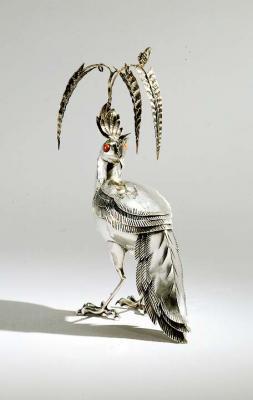
Dagobert Peche, Silver Bird-shaped Candy Box (1920). Image source.
Sadly, Peche’s brilliant career was cut short when he died of cancer in Vienna on April 16, 1923 at the age of 35. (2) While Peche’s work slightly pre-dates the Art-Deco period his geometrically stylized designs were a major influence on designers like René Lalique, Emile-Jacques Ruhlmann, and Jean Dunand.

Dagobert Peche, Large Leaves design for fabric (c. 1920). Image source.
#Dagobert Peche#industrial design#graphic design#arts and crafts movement#art deco#Wiener Werkstatte
4 notes
·
View notes